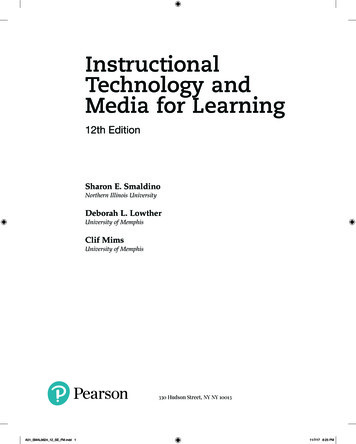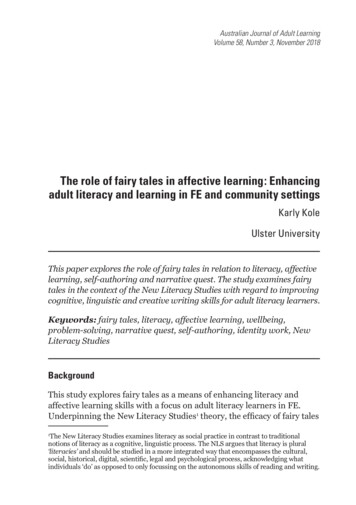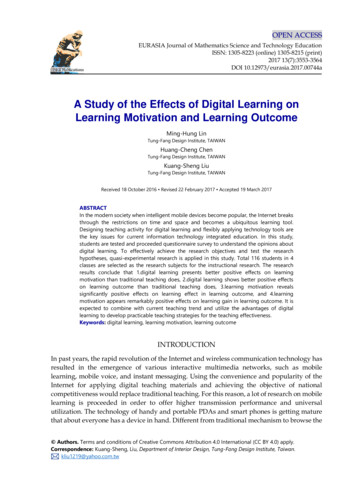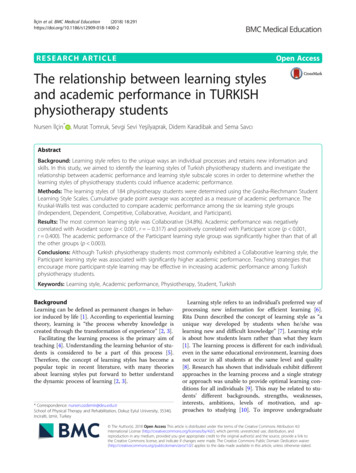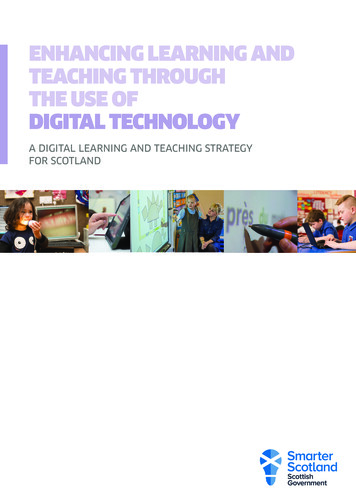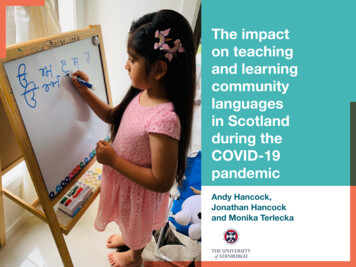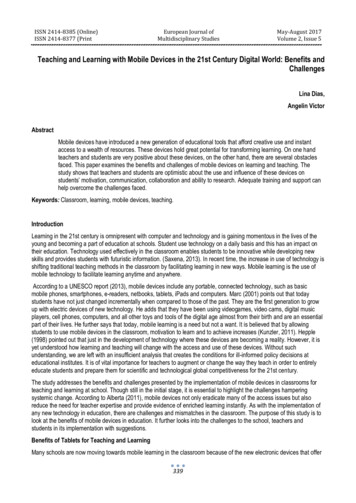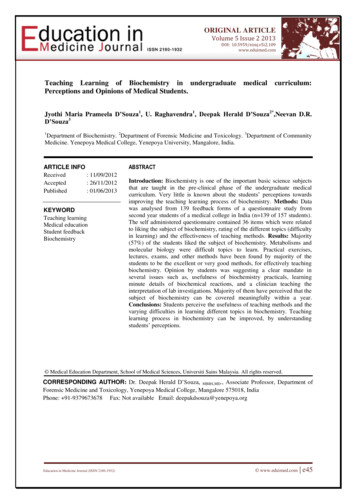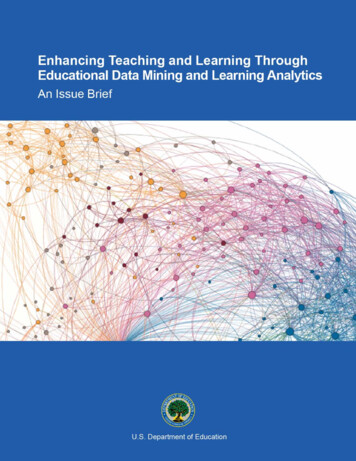
Transcription
Enhancing Teaching and LearningThrough Educational Data Mining and Learning Analytics:An Issue Brief
Enhancing Teaching and LearningThrough Educational Data Mining and Learning Analytics:An Issue BriefU.S. Department of EducationOffice of Educational TechnologyPrepared by:Marie BienkowskiMingyu FengBarbara MeansCenter for Technology in LearningSRI InternationalOctober 2012
This report was prepared for the U.S. Department of Education under Contract Number ED-04CO-0040, Task 0010, with SRI International. The views expressed herein do not necessarilyrepresent the positions or policies of the Department of Education. No official endorsement bythe U.S. Department of Education is intended or should be inferred.U.S. Department of EducationArne DuncanSecretaryOffice of Educational TechnologyKaren CatorDirectorOctober 2012This report is in the public domain. Authorization to reproduce this report in whole or in part isgranted. While permission to reprint this publication is not necessary, the suggested citation is:U.S. Department of Education, Office of Educational Technology, Enhancing Teaching andLearning Through Educational Data Mining and Learning Analytics: An Issue Brief,Washington, D.C., 2012.This report is available on the Department’s Web site at http://www.ed.gov/technology.On request, this publication is available in alternate formats, such as Braille, large print, orcompact disc. For more information, please contact the Department’s Alternate Format Center at(202) 260-0852 or (202) 260-0818.Technical ContactBernadette Adamsbernadette.adams@ed.gov
ContentsList of Exhibits . ivAcknowledgments . vExecutive Summary .viiIntroduction . 1Personalized Learning Scenarios . 5Data Mining and Analytics: The Research Base . 7Educational Data Mining . 9Learning Analytics. 13Visual Data Analytics . 15Data Use in Adaptive Learning Systems . 17Educational Data Mining and Learning Analytics Applications . 25User Knowledge Modeling . 28User Behavior Modeling . 29User Experience Modeling . 30User Profiling . 32Domain Modeling . 33Learning System Components and Instructional Principle Analysis . 34Trend Analysis . 35Adaptation and Personalization . 35Implementation Challenges and Considerations . 37Technical Challenges. 38Limitations in Institutional Capacity . 40Privacy and Ethics Issues . 41Recommendations . 45Educators . 46Researchers and Developers . 49Collaborations Across Sectors . 50Conclusion . 51References. 53Selected Reading. 59Selected Websites . 63iii
ExhibitsExhibit 1. The Components and Data Flow Through a Typical Adaptive Learning System . 18Exhibit 2. Student Dashboard Showing Recommended Next Activities . 19Exhibit 3. Teacher Dashboard With Skill Meter for Math Class . 20Exhibit 4. Administrator Dashboard Showing Concept Proficiency for a Grade Level . 21Exhibit 5 Application Areas for Educational Data Mining and Learning Analytics . 26iv
AcknowledgmentsThis issue brief was developed under the guidance of Karen Cator and Bernadette Adams of theU.S. Department of Education, Office of Educational Technology.At SRI International, Marianne Bakia provided advice and insightful feedback on drafts of thereport. Yukie Toyama (now at the University of California, Berkeley) provided researchassistance. The report was edited by Mimi Campbell. Kate Borelli produced graphics and layout,assisted by Vickie Watts and Yesica Lopez.The authors incorporated many of the thoughts and experiences of the experts interviewed forthis report, Linda Chaput (Agile Mind, Inc.), Michael Freed and Dror Oren (SRI International),David Gutelius (Jive Software), Michael Jahrer and Andreas Toescher (Commendo Inc.,Austria), Phill Miller (Moodlerooms, Inc.), Jeff Murphy (Florida Virtual School), Peter Norvig(Google Inc.), Sunil Noronha (Yahoo! Research Labs), Ken Rudin (Zynga, Inc.), Steve Ritter(Carnegie Learning, Inc.), Bror Saxberg and David Niemi (Kaplan, Inc.), Shelby Sanders(Onsophic, Inc.), and Charles Severance (University of Michigan and Sakai, Inc.).The authors are grateful for the deliberations of our technical working group (TWG) of academicexperts in educational data mining and learning analytics. These experts provided constructiveguidance and comments for this issue brief. The TWG comprised Ryan S. J. d. Baker (WorcesterPolytechnic Institute), Gautam Biswas (Vanderbilt University), John Campbell (PurdueUniversity), Greg Chung (National Center for Research on Evaluation, Standards, and StudentTesting, University of California, Los Angeles), Alfred Kobsa (University of California, Irvine),Kenneth Koedinger (Carnegie Mellon University), George Siemens (Technology EnhancedKnowledge Research Institute, Athabasca University, Canada), and Stephanie Teasley(University of Michigan).v
vi
Executive SummaryIn data mining and data analytics, tools and techniques once confined to research laboratories arebeing adopted by forward-looking industries to generate business intelligence for improvingdecision making. Higher education institutions are beginning to use analytics for improving theservices they provide and for increasing student grades and retention. The U.S. Department ofEducation’s National Education Technology Plan, as one part of its model for 21st-centurylearning powered by technology, envisions ways of using data from online learning systems toimprove instruction.With analytics and data mining experiments in education starting to proliferate, sorting out factfrom fiction and identifying research possibilities and practical applications are not easy. Thisissue brief is intended to help policymakers and administrators understand how analytics anddata mining have been—and can be—applied for educational improvement.At present, educational data mining tends to focus on developing new tools for discoveringpatterns in data. These patterns are generally about the microconcepts involved in learning: onedigit multiplication, subtraction with carries, and so on. Learning analytics—at least as it iscurrently contrasted with data mining—focuses on applying tools and techniques at larger scales,such as in courses and at schools and postsecondary institutions. But both disciplines work withpatterns and prediction: If we can discern the pattern in the data and make sense of what ishappening, we can predict what should come next and take the appropriate action.Educational data mining and learning analytics are used to research and build models in severalareas that can influence online learning systems. One area is user modeling, which encompasseswhat a learner knows, what a learner’s behavior and motivation are, what the user experience islike, and how satisfied users are with online learning. At the simplest level, analytics can detectwhen a student in an online course is going astray and nudge him or her on to a coursecorrection. At the most complex, they hold promise of detecting boredom from patterns of keyclicks and redirecting the student’s attention. Because these data are gathered in real time, thereis a real possibility of continuous improvement via multiple feedback loops that operate atdifferent time scales—immediate to the student for the next problem, daily to the teacher for thevii
next day’s teaching, monthly to the principal for judging progress, and annually to the districtand state administrators for overall school improvement.The same kinds of data that inform user or learner models can be used to profile users. Profilingas used here means grouping similar users into categories using salient characteristics. Thesecategories then can be used to offer experiences to groups of users or to make recommendationsto the users and adaptations to how a system performs.User modeling and profiling are suggestive of real-time adaptations. In contrast, someapplications of data mining and analytics are for more experimental purposes. Domain modelingis largely experimental with the goal of understanding how to present a topic and at what level ofdetail. The study of learning components and instructional principles also uses experimentationto understand what is effective at promoting learning.These examples suggest that the actions from data mining and analytics are always automatic,but that is less often the case. Visual data analytics closely involve humans to help make sense ofdata, from initial pattern detection and model building to sophisticated data dashboards thatpresent data in a way that humans can act upon. K–12 schools and school districts are starting toadopt such institution-level analyses for detecting areas for instructional improvement, settingpolicies, and measuring results. Making visible students’ learning and assessment activitiesopens up the possibility for students to develop skills in monitoring their own learning and to seedirectly how their effort improves their success. Teachers gain views into students’ performancethat help them adapt their teaching or initiate tutoring, tailored assignments, and the like.Robust applications of educational data mining and learning analytics techniques come withcosts and challenges. Information technology (IT) departments will understand the costsassociated with collecting and storing logged data, while algorithm developers will recognize thecomputational costs these techniques still require. Another technical challenge is that educationaldata systems are not interoperable, so bringing together administrative data and classroom-leveldata remains a challenge. Yet combining these data can give algorithms better predictive power.Combining data about student performance—online tracking, standardized tests, teachergenerated tests—to form one simplified picture of what a student knows can be difficult andmust meet acceptable standards for validity. It also requires careful attention to student andteacher privacy and the ethical obligations associated with knowing and acting on student data.viii
Educational data mining and learning analytics have the potential to make visible data that haveheretofore gone unseen, unnoticed, and therefore unactionable. To help further the fields andgain value from their practical applications, the recommendations are that educators andadministrators: Develop a culture of using data for making instructional decisions. Involve IT departments in planning for data collection and use. Be smart data consumers who ask critical questions about commercial offerings andcreate demand for the most useful features and uses. Start with focused areas where data will help, show success, and then expand to newareas. Communicate with students and parents about where data come from and how the dataare used. Help align state policies with technical requirements for online learning systems.Researchers and software developers are encouraged to: Conduct research on usability and effectiveness of data displays. Help instructors be more effective in the classroom with more real-time and data-baseddecision support tools, including recommendation services. Continue to research methods for using identified student information where it will helpmost, anonymizing data when required, and understanding how to align data acrossdifferent systems. Understand how to repurpose predictive models developed in one context to another.A final recommendation is to create and continue strong collaboration across research,commercial, and educational sectors. Commercial companies operate on fast development cyclesand can produce data useful for research. Districts and schools want properly vetted learningenvironments. Effective partnerships can help these organizations codesign the best tools.ix
x
IntroductionAs more of our commerce, entertainment, communication, and learning are occurring over theWeb, the amount of data online activities generate is skyrocketing. Commercial entities have ledthe way in developing techniques for harvesting insights from this mass of data for use inidentifying likely consumers of their products, in refining their products to better fit consumerneeds, and in tailoring their marketing and user experiences to the preferences of the individual.More recently, researchers and developers of online learning systems have begun to exploreanalogous techniques for gaining insights from learners’ activities online.This issue brief describes data analytics and data mining in the commercial world and howsimilar techniques (learner analytics and educational data mining) are starting to be applied ineducation. The brief examines the challenges being encountered and the potential of such effortsfor improving student outcomes and the productivity of K–12 education systems. The goal is tohelp education policymakers and administrators understand how data mining and analytics workand how they can be applied within online learning systems to support education-related decisionmaking.Specifically, this issue brief addresses the followingquestions: What is educational data mining, and how is itapplied? What kinds of questions can it answer, andwhat kinds of data are needed to answer thesequestions?How does learning analytics differ from data mining?Does it answer different questions and use differentdata?What are the broad application areas for whicheducational data mining and learning analytics areused?What are the benefits of educational data mining andlearning analytics, and what factors have enabledthese new approaches to be adopted?Online Learning Systems and AdaptiveLearning EnvironmentsOnline learning systems refer to onlinecourses or to learning software orinteractive learning environments that useintelligent tutoring systems, virtual labs, orsimulations. Online courses may beoffered through a learning or coursemanagement system (such asBlackboard, Moodle, or Sakai) or alearning platform (such as Knewton andDreamBox Learning). Examples oflearning software and interactive learningenvironments are those from Kaplan,Khan Academy, and Agile Mind. Whenonline learning systems use data tochange in response to studentperformance, they become adaptivelearning environments.1
What are the challenges and barriers to successful application of educational data miningand learning analytics?What new practices have to be adopted in order to successfully employ educational datamining and learning analytics for improving teaching and learning?Sources of information for this brief consisted of: A review of selected publications and fugitive or grayliterature (Web pages and unpublished documents) oneducational data mining and learning analytics;Interviews of 15 data mining/analytics experts fromlearning software and learning management systemcompanies and from companies offering other kindsof Web-based services; andDeliberations of a technical working group of eightacademic experts in data mining and learninganalytics.Learning management systems (LMS)LMS are suites of software tools thatprovide comprehensive course-deliveryfunctions—administration, documentation,content assembly and delivery, trackingand reporting of progress, usermanagement and self-services, etc. LMSare Web based and are considered aplatform on which to build and delivermodules and courses. Open-sourceexamples include Moodle, Sakai, andILIAS.This issue brief was inspired by the vision of personalized learning and embedded assessment inthe U.S. Department of Education’s National Education Technology Plan (NETP) (U.S.Department of Education 2010a). As described in the plan, increasing use of online learningoffers opportunities to integrate assessment and learning so that information needed to improvefuture instruction can be gathered in nearly real time:When students are learning online, there are multiple opportunities to exploit the power oftechnology for formative assessment. The same technology that supports learning activitiesgathers data in the course of learning that can be used for assessment. An online systemcan collect much more and much more detailed information about how students are learningthan manual methods. As students work, the system can capture their inputs and collectevidence of their problem-solving sequences, knowledge, and strategy use, as reflected bythe information each student selects or inputs, the number of attempts the student makes, thenumber of hints and feedback given, and the time allocation across parts of the problem.(U.S. Department of Education 2010a, p. 30)While students can clearly benefit from this detailed learning data, the NETP also describes thepotential value for the broader education community through the concept of an interconnectedfeedback system:The goal of creating an interconnected feedback system would be to ensure that keydecisions about learning are informed by data and that data are aggregated and madeaccessible at all levels of the education system for continuous improvement.(U.S. Department of Education 2010a, p. 35)2
The interconnected feedback systems envisioned by the NETP rely on online learning systemscollecting, aggregating, and analyzing large amounts of data and making the data available tomany stakeholders. These online or adaptive learning systems will be able to exploit detailedlearner activity data not only to recommend what the next learning activity for a particularstudent should be, but also to predict how that student will perform with future learning content,including high-stakes examinations. Data-rich systems will be able to provide informative andactionable feedback to the learner, to the instructor, and to administrators. These learningsystems also will provide software developers with feedback that is tremendously helpful inrapidly refining and improving their products. Finally, researchers will be able to use data fromexperimentation with adaptive learning systems to test and improve theories of teaching andlearning.In the remainder of this report, we:1. Present scenarios that motivate research, development, and application efforts to collectand use data for personalization and adaptation.2. Define the research base of educational data mining and learning analytics and describethe research goals researchers pursue and the questions they seek to answer aboutlearning at all levels of the educational system.3. Present an abstracted adaptive learning system to show how data are obtained and used,what major components are involved, and how various stakeholders use such systems.4. Examine the major application areas for the tools and techniques in data mining andanalytics, encompassing user and domain modeling.5. Discuss the implementation and technical challenges and give recommendations forovercoming them.3
4
Personalized Learning ScenariosOnline consumer experiences provide strong evidence that computer scientists are developingmethods to exploit user activity data and adapt accordingly. Consider the experience a consumerhas when using Netflix to choose a movie. Members can browse Netflix offerings by category(e.g., Comedy) or search by a specific actor, director, or title. On choosing a movie, the membercan see a brief description of it and compare its average rating by Netflix users with that of otherfilms in the same category. After watching a film, the member is asked to provide a simple ratingof how much he or she enjoyed it. The next time the member returns to Netflix, his or herbrowsing, watching, and rating activity data are used as a basis for recommending more films.The more a person uses Netflix, the more Netflix learns about his or her preferences and themore accurate the predicted enjoyment. But that is not all the data that are used. Because manyother members are browsing, watching, and rating the same movies, the Netflix recommendationalgorithm is able to group members based on their activity data. Once members are matched,activities by some group members can be used to recommend movies to other group members.Such customization is not unique to Netflix, of course. Companies such as Amazon, Overstock,and Pandora keep track of users’ online activities and provide personalized recommendations ina similar way.Education is getting very close to a time when personalization will become commonplace inlearning. Imagine an introductory biology course. The instructor is responsible for supportingstudent learning, but her role has changed to one of designing, orchestrating, and supportinglearning experiences rather than “telling.” Working within whatever parameters are set by theinstitution within which the course is offered, the instructor elaborates and communicates thecourse’s learning objectives and identifies resources and experiences through which thoselearning goals can be attained. Rather than requiring all students to listen to the same lecturesand complete the same homework in the same sequence and at the same pace, the instructorpoints students toward a rich set of resources, some of which are online, and some of which areprovided within classrooms and laboratories. Thus, students learn the required material bybuilding and following their own learning maps.5
Capturing the Moment of Learning bySuppose a student has reached a place where the next unit isTracking Game Players’ Behaviorspopulation genetics. In an online learning system, thestudent’s dashboard shows a set of 20 different populationThe Wheeling Jesuit University’s Cyberenabled Teaching and Learning throughgenetics learning resources, including lectures by a masterGame-based, Metaphor-Enhancedteacher, sophisticated video productions emphasizing visualLearning Objects (CyGaMEs) project wasimages related to the genetics concepts, interactivesuccessful in measuring learning usingassessments embedded in games.population genetics simulation games, an onlineCyGaMEs quantifies game play activity tocollaborative group project, and combinations of text andtrack timed progress toward the game’spractice exercises. Each resource comes with a rating of howgoal and uses this progress as a measureof player learning. CyGaMEs alsomuch of the population genetics portion of the learning mapcaptures a self-report on the gameit covers, the size and range of learning gains attained byplayer’s engagement or flow, i.e., feelingsstudents who have used it in the past, and student ratings ofof skill and challenge, as these feelingsvary throughout the game play. In additionthe resource for ease and enjoyment of use. These ratings areto timed progress and self-report ofderived from past activities of all students, such as “like”engagement, CyGaMEs capturesindicators, assessment results, and correlations betweenbehaviors the player uses during play.Reese et al. (in press) showed that thisstudent activity and assessment results. The student choosesbehavior data exposed a prototypicala resource to work with, and his or her interactions with it are “moment of learning” that was confirmedused to continuously update the system’s model of howby the timed progress report. Researchusing the flow data to determine how usermuch he or she knows about population genetics. After theexperience interacts with learning isstudent has worked with the resource, the dashboard showsongoing.updated ratings for each population genetics learningresource; these ratings indicate how much of the unit contentthe student has not yet mastered is covered by each resource. At any time, the student maychoose to take an online practice assessment for the population genetics unit. Student responsesto this assessment give the system—and the student—an even better idea of what he or she hasalready mastered, how helpful different resources have been in achieving that mastery, and whatstill needs to be addressed. The teacher and the institution have access to the online learning data,which they can use to certify the student’s accomplishments.This scenario shows the possibility of leveraging data for improving student performance;another example of data use for “sensing” student learning and engagement is described in thesidebar on the moment of learning and illustrates how using detailed behavior data can pinpointcognitive events.The increased ability to use data in these ways is due in part to developments in several fields ofcomputer science and statistics. To support the understanding of what kinds of analyses arepossible, the next section defines educational data mining, learning analytics, and visual dataanalytics, and describes the techniques they use to answer questions relevant to teaching andlearning.6
Data Mining and Analytics: The Research BaseUsing data for making decisions is not new; companies use complex computations on customerdata for business intelligence or analytics. Business intelligence techniques can discern historicalpatterns and trends from data and can create models that predict future trends and patterns.Analytics, broadly defined, comprises applied techniques from computer science, mathematics,and statistics for extracting usable information from very large datasets.An early example of using data to explore online behavior isWeb analytics using tools that log and report Web pagevisits, countries or domains where the visit was from, and thelinks that were clicked through. Web analytics are still usedto understand and improve how people use the Web, butcompanies now have developed more sophisticatedtechniques to track more complex user interactions with theirwebsites. Examples of such tracking include changes inbuying habits in response to disruptive technology (e.g., ereaders), most-highlighted passages in e-books, browsinghistory for predicting likely Web pages of interest, andchanges in game players’ habits over time. Across the Web,social actions, such as bookmarking to social sites, posting toTwitter or blogs, and commenting on stories can be trackedand analyzed.Unstructured Data andMachine LearningData are often put into a structuredformat, as in a relational database.Structured data are easy for computers tomanipulate. In contrast, unstructureddata have a semantic structure that isdifficult to discern computationally (as intext or image analysis) without human aid.As a simple example, an email messagehas some structured parts—To, From,and Date Sent— and some unstructuredparts—the Subject and the Body.Machine learning approaches to datamining deal with unstructured data,finding patterns and regularities in thedata or extracting semantically meaningfulinformation.Analyzing these new logged events requires new techniquesto work with unstructured text and image data, data frommultiple sources, and vast amounts of data (“big data”). Big data does not have a fixed size; anynum
Learning Through Educational Data Mining and Learning Analytics: An Issue Brief, Washington, D.C., 2012.

